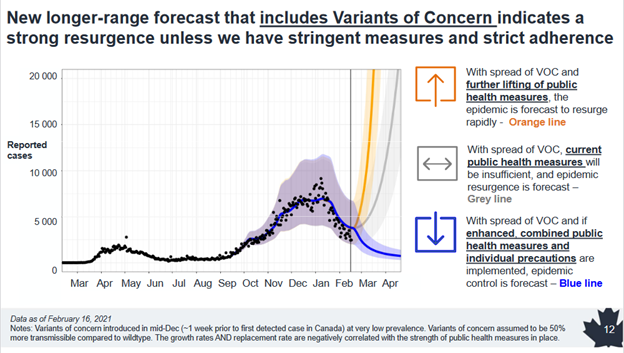As we begin the new year and find ourselves in the heat of a difficult-to-manage second wave of the COVID-19 pandemic, complicated by the arrival of variants, the subject of masks is back as a hot topic.
We all remember how, at the start of the pandemic, most occidental public health authorities said that wearing masks was not recommended for the public, as there was a shortage of medical masks, and there was no scientific proof of effectiveness of non-medical masks (handmade/fabric, later called “face-covering”).
During the summer of 2020, several jurisdictions changed their recommendations, many of them citing new scientific evidence showing some efficacy of face coverings, therefore not aggravating the shortage of medical masks.
For example, in July 2020, the government of Québec published a decree for mandatory wearing of face coverings in public spaces. This decree applied to “visitors” of public spaces, and not to people working in them, for which wearing procedure mask was already a requirement since April 2020. The misinterpretation of this decree, and the fact that procedure masks were still difficult to find at the time, have resulted in a persistent situation, which is to still see today workers wearing face-coverings in workplaces.
Québec’s worker compensation board, the CNESST, tried to correct the situation by publishing a clarification notice, later integrated on its COVID-19 Toolkit to explain that a fabric face-covering was not an acceptable substitute for workers, but it was too late. Several organisations had already purchased fabric face-coverings and distributed them to their employees, and clearly, did not get around to read the CNESST’s clarification notice.
It was not only for the workplaces and public spaces that governmental directives on masks created some confusion in the general population: Fast forward to the fall of 2020, as in-person school started, some jurisdictions imposed the wearing of fabric face coverings, not the surgical masks, only to change, after the holidays, for surgical mask for high school students, while the young ones could continue to wear fabric face coverings.
It is therefore understandable that some confusion remains with respect to what type of mask is acceptable in the workplace.
With the arrival of variants, it is however more important than ever that mask wearing, although at the bottom of the hierarchy of OHS controls, be as effective as it can.
Just to illustrate how using a fabric face covering is like playing Russian roulette in terms of efficacy of protection, a German study (Maurer et al., 2020) evaluated filtration efficiency for 2.8 μm particles of 16 face coverings of different brands. The authors reported a wide variability in the filtration efficiency of a radio-branded saline solution, which ranged from 34.9% to 88.7%, compared to a 99.8% efficacy for a procedure mask.
If your company is still providing or tolerating that its workers and contractors/suppliers wear fabric face coverings, more than ever, it is time to correct the situation, and providing your employees with surgical masks, and asking your contractors to do the same. These masks cannot be just any “procedure mask lookalikes”. Indeed, the only ones that have a guaranteed performance, acceptable to public authorities for use in the workplace, these need to be bear the certification mark to the standard ASTM F2100, EN 14683 or equivalent.
Unfortunately, the procedure masks are not throw-away, so a source of residual matter filling up landfills. The Quebec Government, wanting to minimise the environmental impact of surgical masks has asked the BNQ to come up with a standard for fabric masks which will be as effective as the surgical ones, which was published in December 2020. The intention of this new standard “BNQ 1922-900 Masks intended for Working Environment”1, is to serve as a reference to BNQ’s attestation program that enables mask manufacturers and distributors to have the conformity of their products recognized, and to enable employers, workers, and consumers to quickly identify quality products. This is a file which to monitor as masks complying with BNQ 1922-900 are still rare on the market.
The End of Fabric Face-Coverings?
In USA: “Double-masking”, which came about after the buzz that was generated by attendees of Joe Biden’s inauguration who were all wearing a double-mask, and with Dr. Fauci commenting “it just makes common sense that it likely would be more effective”2, the fate of fabric face coverings was about to change.
Your fabric face-coverings, which are definitively persona non-grata in your workplaces, may have a second life layered on top of surgical masks.
Updated February 24, 2021
This did happen pretty quickly: On February 10th, the CDC released a study entitled “Maximizing Fit for Cloth and Medical Procedure Masks to Improve Performance and Reduce SARS-CoV-2 Transmission and Exposure, 2021"3. The results of this study demonstrated how wearing a cloth face covering over a medical procedure mask greatly improved its effectiveness, because although a medical procedure mask has a great filtration effectiveness, it tends to leave gaps where the air can seep in. Wearing a cloth mask over a surgical one improves the fit.
The CDC vulgarized the content of this study for the public and published it on “Improve the Fit and Filtration of Your Mask to Reduce the Spread of COVID-19”4. A good read not only on how to “double-mask”, but also containing other alternatives to ensure that mask-wearing is optimized.
In conclusion, with the dire warning from the Public Health Agency of Canada on new pandemic projections, including the Variants of Concerns5, wearing masks must offer all the protection it can give.

Do ensure that your employees and third parties working in your workplace are wearing surgical masks and encourage them to their “old” cloth face coverings over their surgical one; killing to birds with one stone: “reuse” of outdated fabric mask and significant increase in their surgical mask’s fit.
Stay safe. Stay healthy. Stay properly masked.
1. https://bnq.qc.ca/en/certification/protection-and-safety/masks-intended-for-working-environments-c.html
2. https://www.cnbc.com/2021/01/25/dr-fauci-double-mask-during-covid-makes-common-sense-more-effective.html
3. https://www.cdc.gov/mmwr/volumes/70/wr/mm7007e1.htm
4. https://www.cdc.gov/coronavirus/2019-ncov/prevent-getting-sick/mask-fit-and-filtration.html
5. https://www.canada.ca/content/dam/phac-aspc/documents/services/diseases-maladies/coronavirus-disease-covid-19/epidemiological-economic-research-data/update-covid-19-canada-epidemiology-modelling-20210219-en.pdf






